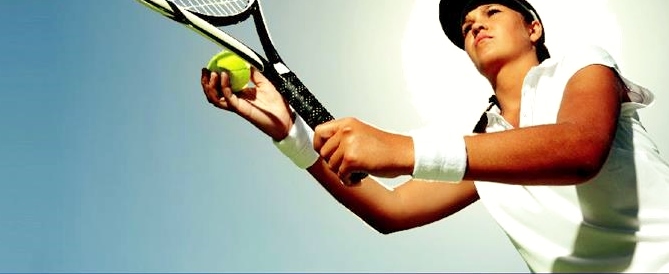Whether you’re a social player or a more experienced player, the characteristics of your racquet may affect your performance and contribute to an increased risk of sustaining a tennis related injury.
A considerable amount of force is generated when a tennis ball hits the racquet and exactly how much of that force is transmitted to the players arm is dependent on a number of factors including the stroke-work/technique of the player, the speed of the ball on impact and the characteristics of your racquet. It is no secret that the qualities of your racquet can significantly reduce elbow and wrist injuries. We take a look at some important features to consider when selecting your tennis racquet.
Racquet head size and the sweet spot
The area in which the strings create the most power for the least amount of effort is known as the sweet spot.
Over-sized or bigger racquet heads which offer between 100 and a 140 square inches of strung surface are usually suitable for beginners as they give you a larger sweet spot, and they allow you to still make a good shot when you hit the ball further from the center of the sweet spot.
More experienced players use a traditional to midsize racquet which offers a surface area between 85 and 105 square inches. Mid-size racquets offers a more maneuverable frame that lets you generate good racquet speed.
Racquet materials
Most racquets today are made from graphite as it is strong and light weight. It provides good power as well as control, making them perfect for any beginner and experienced players. Other racquets are made from boron or Kevlar (used to make bullet proof vests). Although these are light racquets they’re also quite stiff, resulting in the vibrations being transmitted to the arm if the sweet spot is missed. These racquets are more often used by advanced players. Recently new racquets made from a titanium have also hit the market.
The weight
Racquets have become lighter in recent years because of the use of new materials but a lighter racquet doesn’t necessarily make it better. Most racquets now weigh between 240 and 340 grams, unstrung. When choosing your racquet you should be able to feel the weight; It should be heavy enough to provide you with good power but light enough to generate greater swing.
The overall length of the racquet
The traditional length of racquet is about 27 to 28 inches, but you can get longer racquets of up to 29 inches. Longer racquets give you a little more reach and power however they are also a lot more difficult to control and place far greater stress on your arm. Beginners should stick to a standard length racquet (27 inches) and then experiment with longer racquets once they master their control.
Racquet grip size
As a very general rule of thumb place the bottom of the racquet on the middle crease of your palm. The grips size should be equal in length as the point of the handle from the middle crease of your palm to a point equal to the height of the tip of your ring finger.
For more information on choosing the right racquet or tennis related injury management contact one of the physiotherapists at Jubilee Sports Physiotherapy.






















